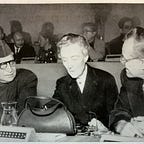Losing lived Afro-Asianism: Kenneth Kaunda and Rambhai Patel
Yesterday, on 17 June 2021, the world lost Kenneth Kaunda. In 1964, he became Zambia’s first president. He is remembered today as a key figure in not just the North Rhodesian struggle for independence, but also for his solidarity with liberation movements elsewhere, particularly in Southern Africa. But Kaunda was also one of the last living figures of early Cold War Afro-Asianism. Both in his political methods and in his personal friendships, Kaunda’s reach spanned multiple continents, and this was especially apparent in his connections with India. As his longtime correspondent and later biographer Colin Morris claimed, Kaunda was “possibly the only world leader since Gandhi to preach and practice non-violence from a position of power.”
It was inevitable that over the years, Kaunda was criticized for practicing pacifism imperfectly, particularly in the context of his support for the freedom movements in Zimbabwe and Namibia. Of this, too, Morris was not unaware, though he added that “only from some university lecture rooms and pulpits do thoughts on grave moral issues emerge as clean-cut propositions marching irresistibly to neat an unambiguous conclusions.” To some extent, it fell to Morris to make sense of Kaunda’s philosophy of non-violence, as the editor of Kaunda’s thoughts on the issue.
As Kaunda himself made clear in his meditation on violence and non-violence, published in 1980 by Collins as Kaunda on Violence, his political methods and ideas drew on many different sources. As obituaries now start to appear in media across the world, photos are recirculated in which Kaunda appears alongside Martin Luther King, Jr., Nelson Mandela, Bayard Rustin, and many others. It is all the more striking that in Kaunda’s own account of his political development, pride of place is given not to well-known political figures but to Rambhai Patel, an Indian shopkeeper in Lusaka, who first furnished Kaunda with his own translations of Gandhi’s writings. Kaunda notes: “I in turn fed these ideas into my earliest political speeches where, it seems to me now, they shone like gems in a river of mud. It was a noble gesture on Rambhai’s part.”
Who was Rambhai Patel? Kaunda’s characterization of him as a shopkeeper does only tell part of a more complex story. He was Kaunda’s exact contemporary, also born in 1924. Besides a shopkeeper, he was one of a larger group of Indians in Lusaka who were affiliated with the African National Congress in the 1950s. As Kamini Krishna has noted, ANC meetings in Lusaka took place in an Indian shop on Cha Cha Cha Road, run by another trader who was an active member of the ANC and later of the United National Independence Party (UNIP), Narain Bhagga. Rambhai Patel, on his part, was involved with the Zambian struggle enough to earn him a local nickname, Kanjombe. It is as Kanjombe that Patel reappears in accounts of the movement. When Kaunda was jailed, Kanjombe provided him with food. And as noted in Living the End of Empire, Kanjombe in fact supported multiple freedom fighters financially, and Kaunda was not the only one to whom he distributed literature on the Indian struggle for independence. As most literature of this kind was proscribed, this type of informal circulation was often the only way to access such texts.
Kaunda does point to Rambhai Patel’s wider engagement with the Zambian struggle for independence when he notes that “of course my friend Patel has always insisted that the help he gave me was an investment in Zambia’s future. He thought it wise to try to spot winners amongst the young hopefuls jostling one another near the top of the heap in the infant nationalist movement.” Between the lines, Rambhai Patel appears as a contemporary, a compatriot, and a friend. In the last words dedicated to Patel in On Violence, Kaunda formulates the relationship as a debt: “I owe Rambhai Patel much and see why Jesus made a shrewd businessman the hero of one of his parables of the Kingdom.”
Kaunda’s later relations with India were much more public. His first visit to the country in 1958 would be continued by state visits in later years. His collaboration with Indian members of the World Peace Brigade, who supported the Zambian struggle from Dar es Salaam, has been described by, among others, Jake Hodder here. But as Gewald, Hinfelaar and Macola note in Living the End of Empire, the majority of Indian traders who supported the nationalist struggle did so in secret, for fear of retaliation from the authorities. The open acknowledgment to Patel in On Violence, then, is a testament to the importance Kaunda attached to Patel as a living connection and connector between independence struggles across Afro-Asia.
